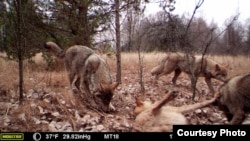A study by an American university of wildlife in the Chernobyl Exclusion Zone (CEZ) confirms that animals are “abundant” in the area.
The zone was created in the aftermath of the April 26, 1986 nuclear disaster at the Chernobyl nuclear power plant in Pripyat, Ukraine.
While other studies had pointed to thriving wildlife, they based their assessment on animal tracks. This study involved using 30 cameras over 94 sites. Researchers also used a “fatty acid scent” to attract animals to the cameras.
The cameras were placed far enough apart to prevent animals from coming to more than one over a 24-hour period.
"The earlier study shed light on the status of wildlife populations in the CEZ, but we still needed to back that up," said James Beasley, an assistant professor with the University of Georgia’s Savannah River Ecology Laboratory and the Warnell School of Forestry and Natural Resources. "For this study we deployed cameras in a systematic way across the entire Belarus section of the CEZ and captured photographic evidence--strong evidence--because these are pictures that everyone can see," said Beasley, the study's lead author.
The Chernobyl Exclusion Zone is about 2,160 square kilometers in size and covers parts of Ukraine and Belarus. Researchers say radiation levels “vary significantly” throughout the region.
The researchers found that “animal distribution is not influenced by radiation levels.”
Over the five-week period of the study, researchers say they observed 14 species of mammals, including gray wolves, the wild or Eurasian boar, red foxes and the raccoon dog,”a canid species found in East Asia and Europe.”
All of the species were seen at camera stations “close to or within the most highly contaminated areas,” researchers said.
"We didn't find any evidence to support the idea that populations are suppressed in highly contaminated areas," Beasley said. "What we did find was these animals were more likely to be found in areas of preferred habitat that have the things they need - food and water."
The study was published in the journal Frontiers in Ecology and the Environment.
The Chernobyl explosion released 400 times more radiation than the atomic bomb dropped on Hiroshima in 1945. It sent a cloud of radioactive fallout into Russia, Belarus and over a large portion of northern Europe.












